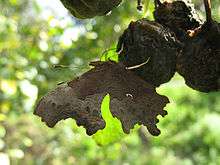Polygonia
Polygonia (from Greek πολύς - polys, "many"[1] and γωνία - gōnia, "angle"[2]) is a genus of butterflies with a conspicuous white mark on the underside of each hindwing, hence the common name comma. They also have conspicuous angular notches on the outer edges of their forewings, hence the other common name anglewing butterflies. The related genus Nymphalis also includes some anglewing species; Polygonia is sometimes classified as a subgenus of Nymphalis.[3]
| Polygonia | |
|---|---|
 | |
| Polygonia c-album | |
| Scientific classification | |
| Kingdom: | Animalia |
| Phylum: | Arthropoda |
| Class: | Insecta |
| Order: | Lepidoptera |
| Family: | Nymphalidae |
| Tribe: | Nymphalini |
| Genus: | Polygonia Hübner, 1819 |
| Species | |
|
See text | |

P. c-album showing angular wings and typical comma marking
Many members of Polygonia hibernate as adults.[4] Species include:[5][6]
- Polygonia c-album (Linnaeus, 1758) – comma
- Polygonia c-aureum (Linnaeus, 1758) – Asian comma
- Polygonia comma (Harris, 1842) – eastern comma
- Polygonia egea (Cramer, 1775) – southern comma
- Polygonia faunus (Edwards, 1862) – Faunus anglewing, Faunus comma, green comma
- Polygonia g-argenteum Doubleday & Hewitson, 1846 – Mexican anglewing
- Polygonia gigantea (Leech, 1883) – giant comma
- Polygonia gracilis (Grote & Robinson, 1867) – hoary comma
- Polygonia haroldii Dewitz, 1877 – spotless anglewing
- Polygonia interposita (Staudinger, 1881)
- Polygonia interrogationis (Fabricius, 1798) – question mark
- Polygonia oreas (Edwards, 1869) – oreas anglewing, oreas comma, sylvan anglewing
- Polygonia progne (Cramer, 1775) – grey comma, gray comma
- Polygonia satyrus (Edwards, 1869) – satyr anglewing, satyr comma
- Polygonia undina (Grum-Grshimailo, 1890)
- Polygonia zephyrus (Edwards, 1870) – zephyr comma
Notes
- πολύς, Henry George Liddell, Robert Scott, A Greek-English Lexicon, on Perseus
- γωνία, Henry George Liddell, Robert Scott, A Greek-English Lexicon, on Perseus
- "Nymphalis Kluk, 1780" at Markku Savela's Lepidoptera and Some Other Life Forms
- Scott, J. A. (1999). Hibernal diapause of North American Papilionoidea and Hesperioidea. Archived 2018-10-08 at the Wayback Machine Journal of Research on the Lepidoptera 18(3):171-200.
- Polygonia, Tree of Life
- Wahlberg, N. et al. (2009). Timing major conflict between mitochondrial and nuclear genes in species relationships of Polygonia butterflies (Nymphalidae: Nymphalini). BMC Evolutionary Biology 9:92.
| Wikimedia Commons has media related to Polygonia. |
| Wikispecies has information related to Polygonia |
gollark: I dislike it for arbitrary reasons.
gollark: https://i.redd.it/dkqvgey43eo51.jpg
gollark: https://images-ext-1.discordapp.net/external/cP0LWskvRRHYcQFwKlaCklt1a-LZIxvJHeRbyxlPG8E/https/i.redd.it/phcegbfp93q51.jpg?width=571&height=421
gollark: æææææ why no embed
gollark: Hmm. I see.
This article is issued from Wikipedia. The text is licensed under Creative Commons - Attribution - Sharealike. Additional terms may apply for the media files.